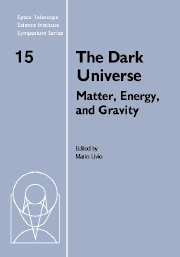Book contents
- Frontmatter
- Contents
- Participants
- Preface
- A brief history of dark matter
- Microlensing towards the Magellanic Clouds: Nature of the lenses and implications on dark matter
- Searching for the Galactic dark matter
- Hot gas in clusters of galaxies and ΩM
- Tracking the baryon density from the Big Bang to the present
- Modified Newtonian Dynamics and its implications
- Cosmological parameters and quintessence from radio galaxies
- The mass density of the Universe
- Growth of structure in the Universe
- Cosmological implications of the most distant supernova (known)
- Dynamical probes of the Halo Mass Function
- Detection of gravitational waves from inflation
- Cosmological constant problems and their solutions
- Dark matter and dark energy: A physicist's perspective
A brief history of dark matter
Published online by Cambridge University Press: 21 August 2009
- Frontmatter
- Contents
- Participants
- Preface
- A brief history of dark matter
- Microlensing towards the Magellanic Clouds: Nature of the lenses and implications on dark matter
- Searching for the Galactic dark matter
- Hot gas in clusters of galaxies and ΩM
- Tracking the baryon density from the Big Bang to the present
- Modified Newtonian Dynamics and its implications
- Cosmological parameters and quintessence from radio galaxies
- The mass density of the Universe
- Growth of structure in the Universe
- Cosmological implications of the most distant supernova (known)
- Dynamical probes of the Halo Mass Function
- Detection of gravitational waves from inflation
- Cosmological constant problems and their solutions
- Dark matter and dark energy: A physicist's perspective
Summary
Introduction
The title not withstanding, this is not a history of dark matter. Until we know what the dark matter is, we cannot know its history. Instead, this is a brief history of how astronomers converged to the view that most of the matter in the universe is dark. This paper deals principally with the early studies which helped to answer the questions “Are rotation curves flat? If so, why?” It also includes some early history in deciphering the signature of clusters of galaxies as gravitational lenses, which seems to have been little investigated. This account covers the years up to 1980; achievements since 1980 are science, not history. Several excellent, informative brief histories exist, and interested readers should see Trimble (1987, 1995) and van den Bergh (1999). We can all thank Sidney van den Bergh for correctly translating Zwicky's “dunkle (kalte) materie” as “dark (cold) matter” and finally putting to rest the myth that Zwicky called it “missing matter.”
The notion that there are stars that are dark was a common one in the 18th and 19th Century. Walt Whitman's (1855) lines in Leaves of Grass, “The bright suns I see and the dark suns I cannot see are in their place” and Bessel's “Foundation of an Astronomy of the Invisible” (Clerke 1885 and reference therein) are early manifestations of this belief.
- Type
- Chapter
- Information
- The Dark UniverseMatter, Energy and Gravity, pp. 1 - 13Publisher: Cambridge University PressPrint publication year: 2004
- 5
- Cited by

